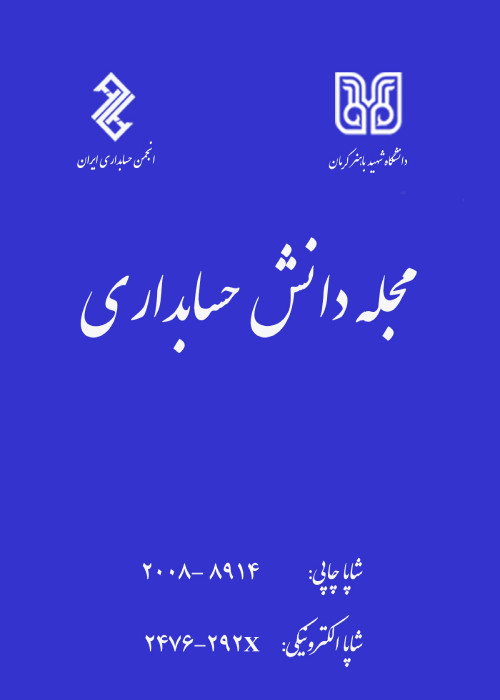Audit Fee: Early Evidence about the Role of Some Omitted Variables
Audit pricing is one of the most critical issues for practitioners and regulators. In Iran, the report of Admission and Supervision Committee of the Trusted Audit Firms of Securities and Exchange Organization in 2009 raised serious concerns about the low audit fees to carry out audit services. "In spite of the actions taken by Iranian Institute of Certified Public Accountants (IACPA), competition to keep engagement with the client firms sometimes leads to fee discounting by the auditors, has raised a confusing problem with certain detrimental effects." However, audit fee studies in Iran are only the replication of foreign research about audit fees. In addition, empirical research of audit fees in Iran suffers from several methodological issues, including omitted correlated variable bias, overlooked environmental circumstances and endogenity issues raised from sample selection bias. This paper attempts to solve these problems and tests the potential role of several environmental variables, such as determining audit fees before starting audit project. In addition, another driver to study this issue is developing the audit fee model for Iranian context as a significant issue for researchers, practitioners and regulators. Hypotheses: Eierle et al. (2021) as the latest review study about the factors influencing the audit fee show the importance of examining the external environment in forming a comprehensive picture of the audit fee framework and understanding global and regional differences. Accordingly, this paper examined the role of two specific variables in the Iranian environment in determining the audit fee and the role of a variable that less attention has been paid to it. In Iran, the audit contract is signed with a determined fee prior to starting the audit project (MohammadRezaei and Faraji, 2019). However, "escape" clauses are usually included in the contract allowing the auditor to perform additional work and receive overtime payments in an unobservable situation, including the going concern issues or other factors affecting the audit risk (Palmrose, 1987: Hassanzadeh Baradaran et al., 2015). In other words, one of the essential factor in determining the audit fees of current year is the audit fees of last year, not the actual audit hours (effort) of current year. In addition, determining the audit fee before starting of the audit project raises the question of whether the current year's fee is more in line with the current characteristics of the client firm or with the last year's characteristics of the client. It is important to note that what information the auditor has about the client when determining the fee? Clearly, when the audit fee is determined, the financial statements of the client firm is not available for current year. The auditor has more access to the information of the last year's audited financial statements and the last year's audit report. Finally, we used the ‘bundle pricing strategy’ in marketing (loyd, 2016) to predict the possible relationship between the role of mid-term audit fees and end-of-period audit fees. Consistent with the bundle pricing view, it can be argued that auditors may consider the mid-term and end-of-term fees as a single bundle pricing to reap the benefits.
1029 firm-year observations were collected from companies listed on Tehran Stock Exchange for seven years, from 2011 to 2017. Two regression models are estimated using ordinary least squares and generalized method of moments to examine research hypotheses.
The findings reveal that the audit fee of the last year is used as an essential basis for determining the audit fee of the current year. This is the case, because in Iran the audit fee is determined before starting audit project. Such a finding is also supported by both the ordinary least squares model and the generalized method of moments. In addition, the findings show that the current year's audit fee is associated with some characteristics of the client firm and the audit project in last year. Despite determining the audit fee prior to the audit project starting and the availability of the client characteristics and the audit project of the last year at the time of determining the current year’s fee, after the completing the audit project of current year, the auditors are able to adjust their audit fee by amending the contract. The results also showed that the interim audit fee is negatively correlated with the end-of-term audit fee. Such a finding provides very original evidence consistent with the bundle pricing perspective.
The findings of this study indicate that the factors affecting the audit fee in the Iranian audit market are different from what prior research were documented at the international era. Such evidence suggests that both legislators and researchers should consider the environmental factors in legislation and audit fee studies. In addition, it is suggested that small audit firms and the audit firms without specific guidelines for determining audit fees use the model presented in this study because only last year's fee is not the basis in determining the current year's audit fee. In addition, since last year's fee affects the current year's audit fee, it is suggested that audit fee contracts be set flexibly between the audit firm and the client. Finally, given that the importance of bundling pricing approach in a competitive audit market, it is suggested that audit firms consider mid-term and end-of-term fees as a bundle. In this case, the auditors can consider a discount for each of the mid-term or end-of-term fees, depending on the circumstances, in order to obtain the client's consent and keep the job.
- حق عضویت دریافتی صرف حمایت از نشریات عضو و نگهداری، تکمیل و توسعه مگیران میشود.
- پرداخت حق اشتراک و دانلود مقالات اجازه بازنشر آن در سایر رسانههای چاپی و دیجیتال را به کاربر نمیدهد.



